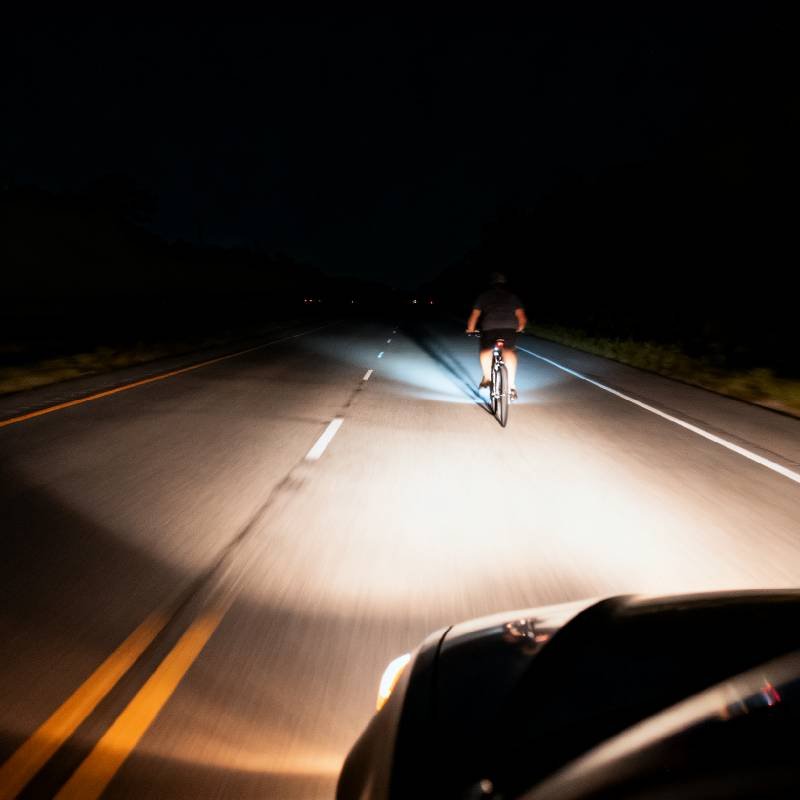Nighttime Driving Safety: Never Hit An “Invisible” Cyclist Again
The “invisible” cyclist, the dark road—a deadly mix. Unlock nighttime driving safety secrets with our life-saving thermal tech guide.
That Heart-Stopping Moment Every Driver Fears
It’s 2 AM. You’re driving home on a dark, unlit country road. Your headlights are the only thing cutting through the pitch black.
Suddenly, a blur darts out from the shadows.
It’s a cyclist. No bike light. No helmet. Wearing a dark hoodie.
Your heart hammers. You slam on the brakes. The tires screech. You stop, just a few feet away. Your hands shake on the wheel.
If this dread is familiar, you’re not alone. Achieving true nighttime driving safety in the US is a major challenge. It’s not about being careless. Our eyes have serious limitations in the dark, making how to see better when driving at night a critical skill.
Add blinding high beams, thick fog, or heavy rain, and spotting unprotected people becomes almost impossible. By the time you see them, it’s often too late. This critical issue of nighttime driving safety is what we will solve in this guide.
We’ll break down why these night driving accidents happen. We’ll use real data to show the danger. And we’ll give you a real plan—from driving habits to advanced tech—to finally feel safe after dark.
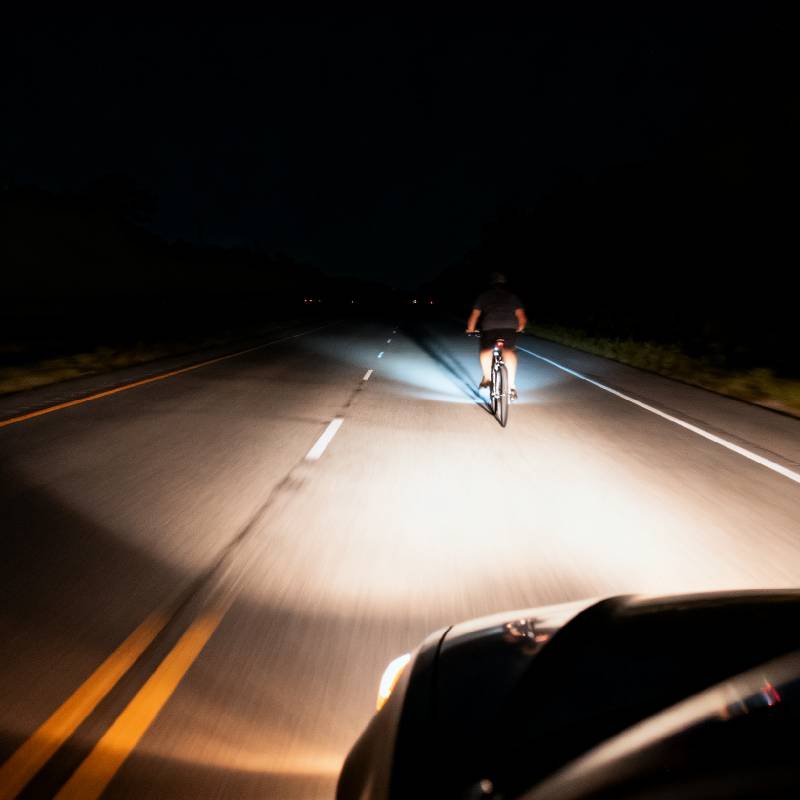
The Hard Truth: Data and Science Expose the Nighttime Driving Safety Crisis
The Sobering Statistics Behind Nighttime Driving Safety
The danger isn’t just a feeling. It’s backed by hard data from US authorities, providing crucial night driving statistics everyone should know.
The Insurance Institute for Highway Safety (IIHS) states that a pedestrian is seven times more likely to be killed at night. On unlit roads, pedestrians and cyclists with no reflective gear are invisible until it’s too late.
The National Highway Traffic Safety Administration (NHTSA) reports that while only 25% of driving is at night, a staggering 58% of all traffic fatalities occur after dark. This makes the fatality rate per mile 2.6 times higher at night.
These numbers prove that nighttime driving safety is one of the most critical aspects of road safety. The risk on poorly lit suburban and rural roads is immense.
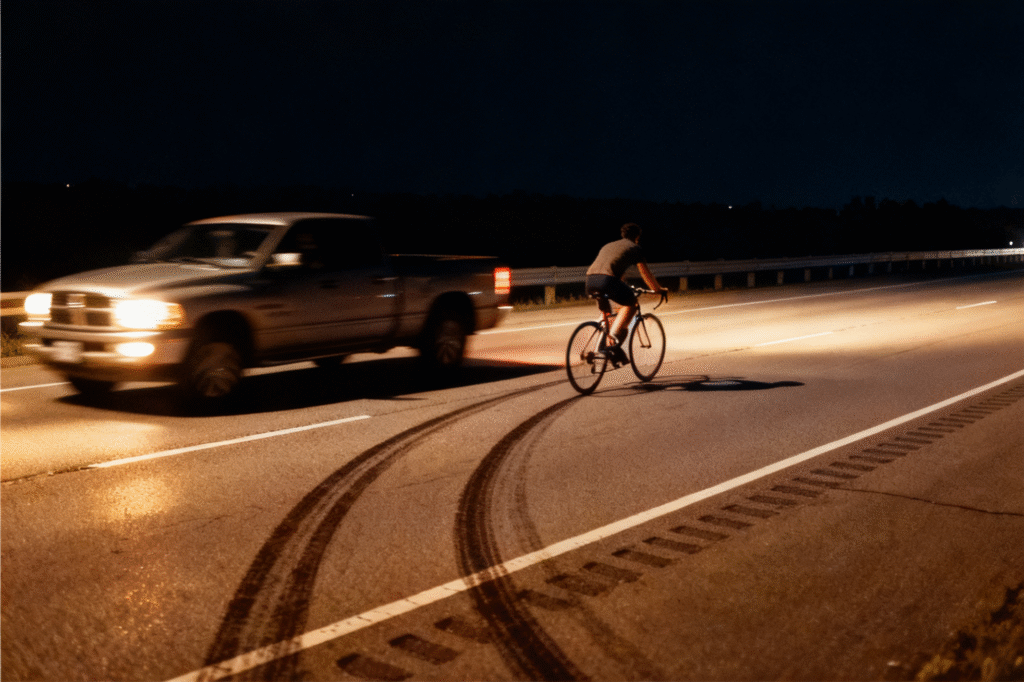
Why Your Brakes Aren’t Enough for Nighttime Driving Safety
Many think, “I have fast reflexes. I can brake in time.” The reality is harsher, and understanding stopping distance at night is key.
Stopping your car involves reaction time and braking distance. Combined, they need more space than you have at night.
At 40 mph, you travel about 59 feet per second. With a 1.5-second reaction time, your car moves 88 feet before you even touch the brake.
Then, braking adds another 45 feet on dry pavement. Your total stopping distance is 133 feet.
But how far can you see at night? Low beams only illuminate 30-50 feet. High beams reach 150 feet, but you must turn them off for oncoming traffic.
This is the core nighttime driving safety problem: By the time your eyes see a hazard, it’s often within 80 feet. At that point, braking is often too late.
It’s not about slow reflexes. It’s about physics and human vision.
Why Standard Equipment Fails Your Nighttime Driving Safety
So, what about your car’s standard systems? Your headlights, dashcam, or driver-assist features all have major flaws for night hazards, compromising your nighttime driving safety.
Headlights create a “wall of light” in fog or rain. They only light up straight ahead, missing people stepping out from the sides.
Standard Dash Cams are “low-light” cameras, not “no-light” cameras. They need ambient light and are blind on truly dark roads, failing as a dashcam for night driving.
Built-in Safety Systems (like AEB) see their effectiveness drop at night. IIHS found AEB’s pedestrian detection is 40% lower after dark.
For complete nighttime driving safety, you need a solution that sees far, sees clearly, and is immune to weather and glare.
Your Nighttime Driving Safety Game Plan: A Two-Layer Defense
You need a two-layer strategy: “soft” skills and “hard” tech. Together, they create a complete nighttime driving safety system for safe night driving.
Layer 1: Sharpen Your Nighttime Driving Safety Habits
These night driving tips are your essential first line of defense for nighttime driving safety.
Slow Down. Seriously. The most effective tactic. On a poorly lit road, drive 5-10 mph under the limit. This drastically shortens stopping distance and is a fundamental night driving safety tip.
Master “Visual Scanning.” Don’t stare ahead. Every 3-5 seconds, scan: look ahead, at the roadside, into shadows, and check your mirrors.
Predict the Unpredictable. Look for clues. A stop sign ahead? Someone might run it. A parked delivery truck? A person could dart out. Think ahead about nighttime driving safety hazards.
These habits form the foundation of effective nighttime driving safety.
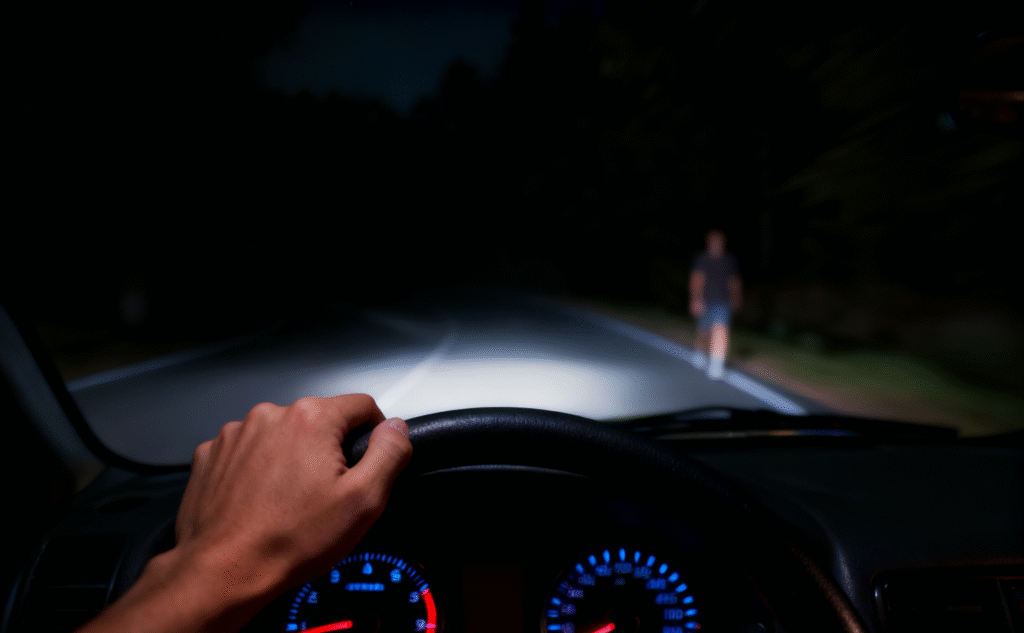
Layer 2: The Tech Upgrade for Ultimate Nighttime Driving Safety
Good habits reduce risk, but they can’t overcome the “I can’t see it” problem. This is where technology fills the critical gap for nighttime driving safety.
First, do the basics. Upgrade old halogen headlights to brighter LEDs. Keep your windshield perfectly clean.
Then, there’s the game-changer for nighttime driving safety: Thermal Imaging Technology.
Think of it as a “heat camera.” It doesn’t need light. It sees the heat emitted by objects. People, animals, and vehicles all show up clearly as bright shapes, no matter the darkness, making it a powerful night vision camera for cars.
This technology is revolutionizing nighttime driving safety with four key advantages:
- Total Darkness Vision. No streetlights? No problem. It sees based on heat.
- All-Weather Sight. Unlike light, heat passes through fog, rain, and snow.
- Complete Glare-Proof Operation. Oncoming high beams have zero effect.
- Long-Range Life Detection. It spots people or animals hundreds of feet away.
This tech was once only for the military or luxury cars. Now, it’s accessible for everyone serious about nighttime driving safety.
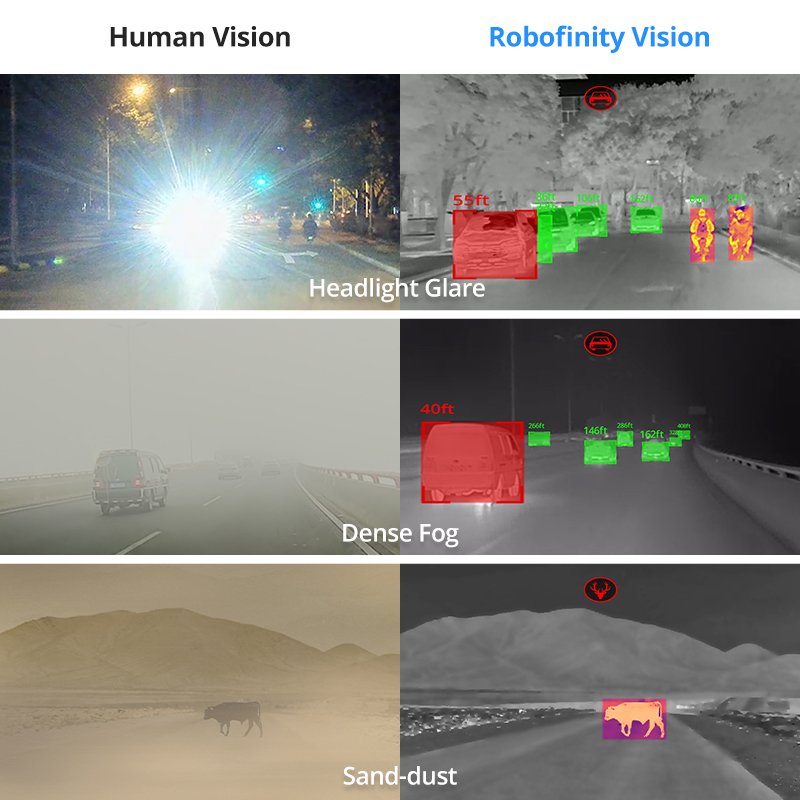
The Modern Solution: How Thermal Imaging Redefines Nighttime Driving Safety
In searching for the best nighttime driving safety solutions, thermal imaging consistently stands out. Based on our testing, one product that effectively delivers this technology is the Robofinity InsightDrive.
It’s a dedicated system designed to tackle the specific challenges of nighttime driving safety.
1. Your “Third Eye” for Enhanced Nighttime Driving Safety
The core of the Robofinity InsightDrive is its thermal camera. On a dark road, it can display heat signatures up to 656 feet (200 meters) away.
This range is far longer than the 133-foot stopping distance. You get an early warning, giving you ample time to react calmly. According to user reviews, this long-range detection is a cornerstone of its nighttime driving safety benefits, helping avoid collisions with unseen hazards.
2. Unbeatable All-Weather Nighttime Driving Safety
Our testing confirmed its all-weather capability. In dense fog where headlights failed, the thermal display clearly showed the road ahead. It also completely ignored blinding high beams. This reliability in all conditions is vital for complete nighttime driving safety.
3. A Calm Co-Pilot for Your Nighttime Driving Safety
The device doesn’t just show a heat picture; its AI identifies and categorizes threats. It outlines pedestrians in red, vehicles in yellow, and cyclists in green.
Furthermore, the alerts are designed to be helpful, not startling. You get a gentle audio cue, not a jarring alarm. You can even customize the alert distance. This thoughtful design is crucial for non-panicky nighttime driving safety.
4. Instant Setup for Immediate Nighttime Driving Safety
A common worry is complicated installation. The InsightDrive eliminates this. It’s powered through your 12V car cigarette lighter socket.
This is a plug-and-play solution—no wiring, no modifications. You can install it in under five minutes and immediately enhance your nighttime driving safety.
Frequently Asked Questions (FAQ)
Q: Does thermal imaging work in hot summer weather?
A: Yes, absolutely. It detects temperature differences. A person stands out clearly against hot asphalt or cooler night air, making it reliable for nighttime driving safety in any season.
Q: Will installing this void my car’s warranty?
A: No. Since it uses the 12V socket and requires no permanent modifications, it does not affect your vehicle’s factory warranty.
Q: Can it record video for evidence?
A: Yes. It offers real-time video recording and supports a Micro SD card up to 128GB, which can be crucial for nighttime driving safety documentation and insurance claims.
Q: Does it drain the car battery?
A: No. It’s designed to power on and off with your vehicle. When you turn off the ignition, it shuts down automatically.
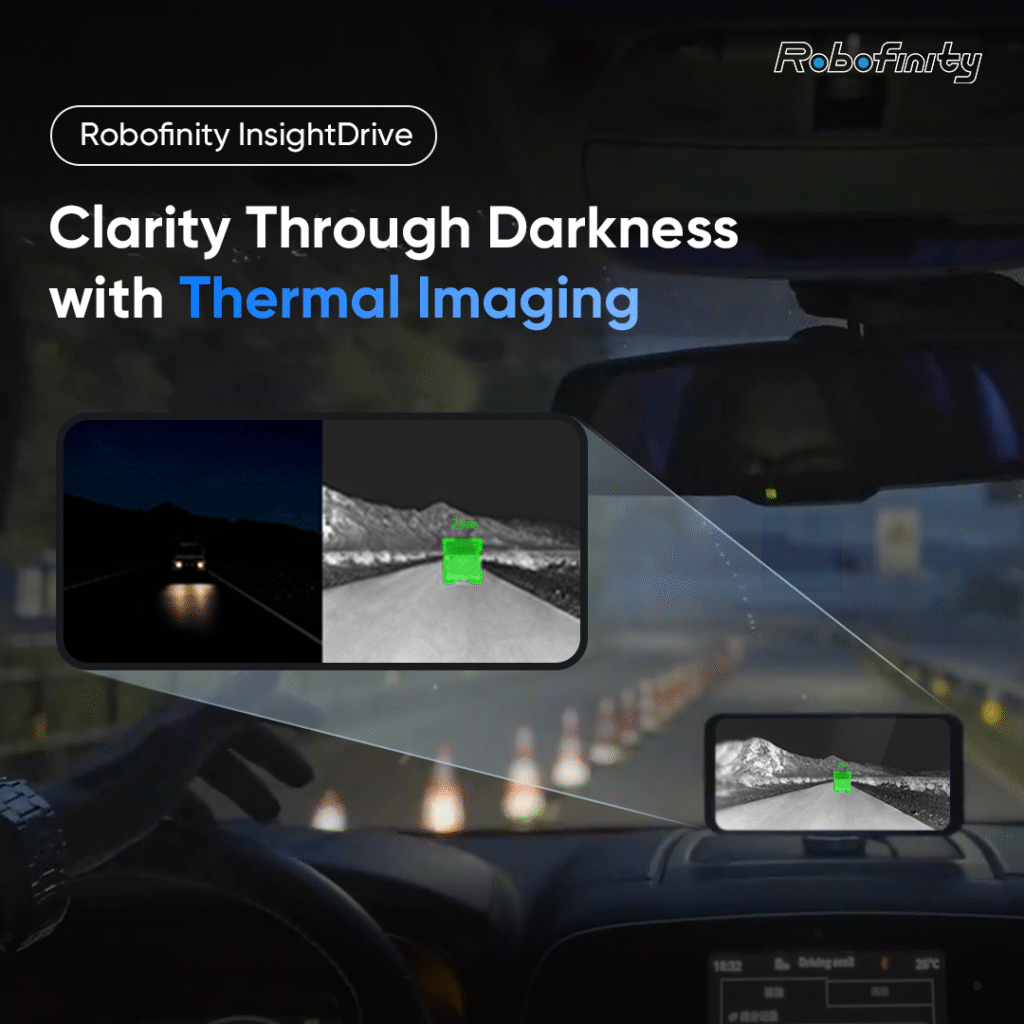
Conclusion: Prioritize Your Nighttime Driving Safety Today
The risks of night driving are real. The data from IIHS and NHTSA proves it. Our own eyes are ill-equipped for the task. Achieving true nighttime driving safety is not just about being more careful; it’s about solving the fundamental problem of not being able to see.
Think of it like walking in a thick fog. Being careful helps, but what you really need is a tool that cuts through that fog. Based on our research, modern thermal imaging provides that crucial vision for improving night vision while driving.
Investing in advanced nighttime driving safety technology is one of the most valuable decisions you can make for your safety and the safety of others on the road.
Don’t let a single moment of darkness lead to a lifetime of regret. Take control of your nighttime driving safety now. The peace of mind it brings is truly priceless.

